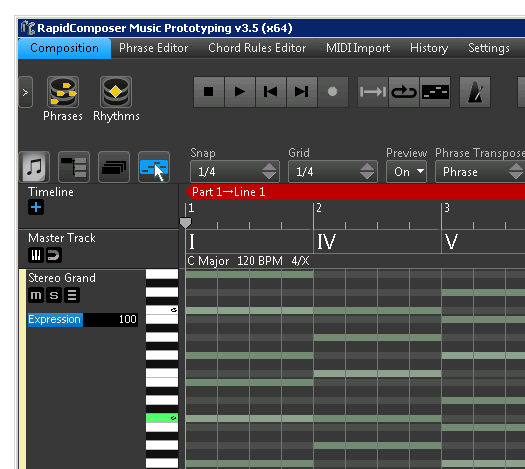
- CAPTURE MIDI OUT RAPIDCOMPOSER HOW TO
- CAPTURE MIDI OUT RAPIDCOMPOSER FULL
- CAPTURE MIDI OUT RAPIDCOMPOSER PRO
- CAPTURE MIDI OUT RAPIDCOMPOSER SOFTWARE
There are two main differences with the fader: (1) when you reach the first or last position, you can’t go further (2) when you move it, it is smoother because you don’t feel each one of the 128 positions.
CAPTURE MIDI OUT RAPIDCOMPOSER PRO
We will need to create « rules » and this is only available in the Pro version. (From here on out, I will call it BMT.) There are two versions of BMT: Classic and Pro (the latter costs €59).
CAPTURE MIDI OUT RAPIDCOMPOSER SOFTWARE
Here, we will use Bome Midi Translator as our software for setting up the MIDI console. Thus, you can only edit an image through what can be done with keyboard shortcuts. Instead, the console sends a message through USB, and software or a plugin converts this message to a keyboard combination that is received by your photography program. Let me first explain how things work: the MIDI console doesn’t directly control Lightroom, Capture One or any other program. How a MIDI Console Works for Photo Editing

CAPTURE MIDI OUT RAPIDCOMPOSER HOW TO
I will first explain how to perform some specific tasks so that you can have an idea of the ranges of options.
CAPTURE MIDI OUT RAPIDCOMPOSER FULL
This will not be a full tutorial since I only looked for solutions for a few specific problems. This article will be more focused on Capture One but can be used for any software that uses keyboard shortcuts.

In this article, I will share with you what I have learned. While searching online, I found a YouTube video, but it didn’t go far enough for me. From what I have understood, the reason seems to be that Lightroom has official support of MIDI console with an API, but Capture One doesn’t. However, with Capture One, I struggled to find proper tutorials on how to use a MIDI console. If you are using Lightroom, you can find plenty of tutorials online that use a plugin called Midi2LR (there are perhaps also others, I didn’t dig into it) which seems to be working smoothly. Moreover, as you will see, you can customize your MIDI console to a level that can’t be achieved with most of the other products. For example, Capture One introduced recently new sliders for Blacks and White, and then a new slider for Dehaze, and I am not sure I could have taken full control of it with Loupedeck. Besides the lower price, I preferred this option to something like Loupedeck because it can be fully customized and is thus more future-proof: If new options become available in my favorite software, I can easily adapt my configuration to take advantage of it. I went with the Behringer X-Touch Mini because of the low price of around €50 ($60) to try it. So, I decided to purchase a MIDI console – a general term for a controller usually intended for making electronic music – to try it instead. This is something that I thought could be fun, but products from Loupedeck or Tangent cost more than $200, which is too expensive for something I wasn’t 100% sure I’d use. You may have heard about it too, because some of them were reviewed here, here and here on PhotographyLife. Some time ago, I heard about using consoles to control Lightroom.


 0 kommentar(er)
0 kommentar(er)
